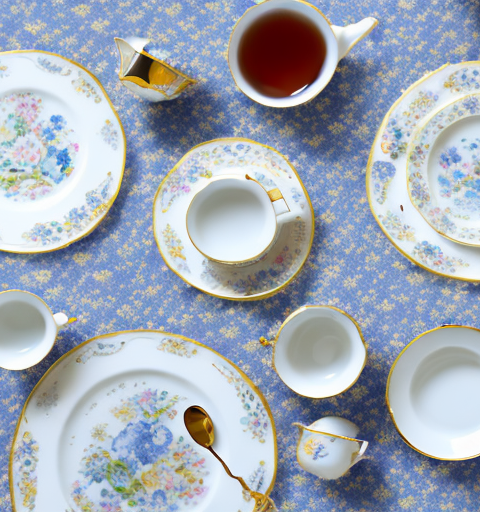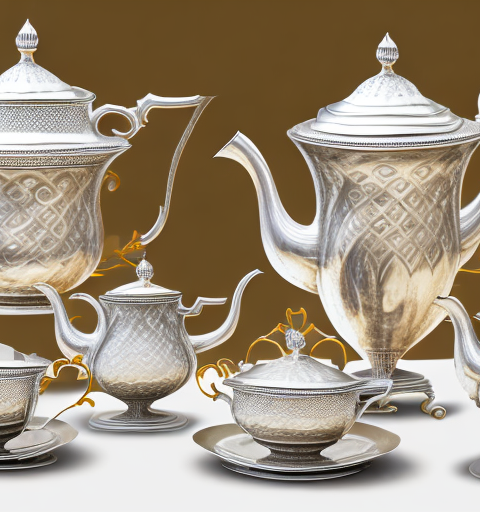Cleaning your ceramic teapot is an essential practice to ensure its longevity and maintain its pristine appearance. However, when it comes to choosing the right cleaning method, many people wonder if using soap is suitable for this task. In this article, we will explore the importance of cleaning your ceramic teapot, different cleaning methods, the pros and cons of using soap, step-by-step guide on cleaning with soap, how to choose the right soap, common mistakes to avoid, alternative cleaning solutions, debunking myths, proper maintenance, addressing concerns about residue and taste, expert recommendations, exploring natural and homemade cleaning solutions, and understanding the impact of soap on the longevity of your ceramic teapot. So let’s dive in!
Understanding the Importance of Cleaning Your Ceramic Teapot
Cleaning your ceramic teapot is not just about aesthetics; it plays a crucial role in maintaining its functionality and ensuring the quality of your tea. Over time, mineral deposits, tannins, and oils can build up on the surface of your teapot, affecting the taste and aroma of your brew. Regular cleaning prevents these residues from impacting the flavor and allows you to enjoy a delightful cup of tea every time.
Furthermore, cleaning your teapot prevents the growth of mold, bacteria, and other contaminants that can thrive in a damp environment. By keeping your teapot clean, you ensure that your tea remains safe to consume, protecting your health and well-being.
Moreover, proper cleaning and maintenance extend the lifespan of your ceramic teapot, allowing you to enjoy its beauty and functionality for years to come. By investing time and effort into cleaning, you preserve the integrity of the materials and prevent potential damage caused by neglect or improper care.
Additionally, cleaning your ceramic teapot regularly helps to remove any stains or discoloration that may occur over time. This is especially important if you use your teapot for different types of tea, as certain teas can leave behind stubborn stains. By keeping your teapot clean, you can maintain its original appearance and ensure that it continues to be a beautiful addition to your tea-drinking experience.
Exploring Different Cleaning Methods for Ceramic Teapots
When it comes to cleaning your ceramic teapot, there are various methods you can choose from. Some people prefer using natural solutions, while others opt for store-bought cleaners or dish soap. Let’s explore some of these cleaning methods:
1. Natural Cleaning Solutions: Natural cleaning solutions, such as vinegar or lemon juice mixed with water, can effectively remove mineral deposits and stains from the surface of your ceramic teapot. These solutions are gentle yet powerful enough to tackle the buildup without causing any damage.
2. Store-Bought Ceramic Cleaners: There are numerous ceramic cleaning products available in the market specifically designed to clean teapots and remove stains. These cleaners are formulated to be gentle on ceramic surfaces while effectively eliminating residue and maintaining the teapot’s appearance.
3. Dish Soap: Yes, you can use dish soap to clean your ceramic teapot. However, it is important to understand the pros and cons of using soap before incorporating it into your cleaning routine.
4. Baking Soda Paste: Another effective method for cleaning ceramic teapots is using a baking soda paste. Mix baking soda with a small amount of water to create a thick paste. Apply the paste to the stained areas of the teapot and let it sit for a few minutes. Then, scrub gently with a soft sponge or brush and rinse thoroughly. Baking soda is known for its abrasive properties, which can help remove tough stains without scratching the ceramic surface.
5. Boiling Water: Boiling water can be a simple yet effective method for cleaning ceramic teapots. Fill the teapot with boiling water and let it sit for a few minutes. The heat from the water will help loosen any residue or stains. Afterward, pour out the water and rinse the teapot with cold water. This method is particularly useful for removing tea stains and freshening up the teapot.
The Pros and Cons of Using Soap to Clean Your Ceramic Teapot
Using soap to clean your ceramic teapot has its advantages and disadvantages. Let’s take a closer look at them:
1. Pros:
– Soap is readily available in most households, making it a convenient option for cleaning your teapot.
– Soap is effective in removing grease and oil, ensuring a thorough clean.
– It is relatively safe and gentle on the ceramic surface if used properly.
2. Cons:
– Soap residue can affect the taste of your tea if not rinsed off completely.
– Some soaps may contain harsh chemicals that can potentially damage the ceramic surface or leave behind a film.
– Excessive or prolonged use of soap may cause the glaze to deteriorate over time.
3. Soap can help remove stubborn stains and discoloration from your ceramic teapot, restoring its original appearance.
4. Using soap to clean your teapot can be a time-consuming process, as it requires thorough rinsing to ensure no residue is left behind.
Step-by-Step Guide on Cleaning Your Ceramic Teapot with Soap
When using soap to clean your ceramic teapot, follow these step-by-step instructions to ensure proper cleaning:
1. Prepare a mild soapy solution by mixing a small amount of dish soap with warm water.
2. Disassemble any removable parts, such as the lid and infuser, and clean them separately.
3. Gently scrub the interior and exterior of the teapot using a soft sponge or cloth soaked in the soapy solution. Pay attention to the areas with stains or buildup.
4. Rinse the teapot thoroughly with warm water, ensuring all soap residue is removed.
5. Allow the teapot to air dry completely before reassembling and storing it.
6. It is important to note that not all ceramic teapots are dishwasher safe. Before using soap to clean your teapot, check the manufacturer’s instructions or packaging to ensure that it can be safely washed with soap and water. Some teapots may require alternative cleaning methods, such as using vinegar or baking soda.
Tips for Choosing the Right Soap for Cleaning Your Ceramic Teapot
Choosing the right soap for cleaning your ceramic teapot is crucial to ensure effective cleaning without causing any damage. Here are some tips to help you select the most suitable soap:
1. Use a mild dish soap: Opt for a mild dish soap that is free from harsh chemicals, fragrances, and dyes. These gentle soaps are less likely to leave behind residue or damage the ceramic surface.
2. Read labels: Before purchasing a soap, carefully read the labels and product descriptions to ensure it is safe for use on ceramics.
3. Consider natural or eco-friendly options: If you prefer more environmentally friendly options, look for natural or eco-friendly dish soaps that are biodegradable and safe for the environment.
4. Test it out: If you are unsure about a particular soap, try it on a small, inconspicuous area of your teapot first to check for any adverse reactions.
5. Avoid abrasive soaps: Stay away from abrasive soaps or cleaners that can scratch or damage the delicate ceramic surface of your teapot. These can leave permanent marks and affect the overall appearance of your teapot.
6. Consider specialized teapot cleaners: There are specific cleaners available in the market that are specially formulated for cleaning ceramic teapots. These cleaners are designed to effectively remove stains and buildup without causing any harm to the teapot’s surface.
Common Mistakes to Avoid when Using Soap to Clean Your Ceramic Teapot
While using soap to clean your ceramic teapot can be a great cleaning method, it is essential to avoid these common mistakes:
1. Using abrasive or harsh cleaning sponges: Avoid using abrasive sponges or scrubbers as they can scratch the ceramic surface.
2. Using excessive soap: Using too much soap can leave behind a residue that alters the taste of your tea. Use a small amount of soap and ensure it is thoroughly rinsed off.
3. Neglecting to rinse properly: Failing to rinse off all the soap residue can result in a soapy taste in your tea. Take the time to rinse the teapot thoroughly with warm water.
4. Using high temperatures: Avoid cleaning your ceramic teapot with boiling water or subjecting it to extreme temperature changes. Sudden changes in temperature can cause cracking or damage to the teapot.
5. Avoid using harsh chemicals: While soap is generally safe for cleaning ceramic teapots, it is important to avoid using harsh chemicals such as bleach or ammonia. These chemicals can damage the ceramic surface and leave behind harmful residues.
6. Be gentle when scrubbing: When using a sponge or cloth to clean your ceramic teapot, make sure to apply gentle pressure. Scrubbing too vigorously can cause the glaze to wear off or create scratches on the surface of the teapot.
Alternative Cleaning Solutions for Ceramic Teapots without Soap
If you prefer not to use soap, there are alternative cleaning solutions you can try:
1. Vinegar and Water: Mix equal parts of vinegar and water to create a solution. Soak your ceramic teapot in the solution for a few hours, then scrub gently and rinse thoroughly.
2. Baking Soda Paste: Create a paste using baking soda and water. Apply the paste to the stains or buildup on your teapot and scrub gently with a soft sponge. Rinse thoroughly.
3. Denture Tablets: Drop a denture cleaning tablet into warm water and place your teapot inside. Let it sit for the recommended time, then rinse thoroughly.
Remember to test these alternative solutions on a small, inconspicuous area first to ensure they do not cause any damage or affect the teapot’s appearance.
4. Lemon Juice: Squeeze fresh lemon juice and mix it with warm water. Dip a soft cloth or sponge into the lemon juice solution and gently scrub the teapot. Rinse thoroughly to remove any residue.
5. White Vinegar and Baking Soda: Create a paste by mixing equal parts of white vinegar and baking soda. Apply the paste to the stained areas of the teapot and let it sit for a few minutes. Scrub gently with a soft brush or sponge, then rinse thoroughly.
Debunking Myths about Using Soap on Ceramic Teapots
There are a few common myths surrounding the use of soap on ceramic teapots. Let’s address them:
1. Myth: Soap ruins the taste of tea. It is true that soap residue can affect the taste of tea; however, if rinsed off properly, the teapot will not retain any soapy taste.
2. Myth: Soap breaks down the glaze. While prolonged and excessive use of soap may cause the glaze to deteriorate over time, regular and proper cleaning with soap should not damage the teapot.
3. Myth: All soaps are safe for ceramics. Not all soaps are suitable for cleaning ceramics, as some may contain harsh chemicals that can damage the surface. It is important to choose a suitable and mild soap.
How to Properly Maintain the Cleanliness of Your Ceramic Teapot
To maintain the cleanliness of your ceramic teapot, follow these practices:
1. Clean after each use: Rinse the teapot with warm water and wipe off any residual tea or stains.
2. Regular deep cleaning: Conduct a deep cleaning using soap or other cleaning methods mentioned above every few weeks or as needed.
3. Dry thoroughly: After cleaning, ensure the teapot is completely dry before storing it to prevent the growth of mold or mildew.
4. Avoid stacking: When storing your ceramic teapot, avoid stacking it with other items, as this can lead to scratching or chipping.
5. Handle with care: Be gentle when handling your teapot to prevent accidental drops or damage.
Addressing Concerns about Residue and Taste after Using Soap on Your Ceramic Teapot
If you are concerned about residue or taste after using soap to clean your ceramic teapot, here are some measures you can take to minimize any potential issues:
1. Thorough rinsing: Rinse the teapot thoroughly with warm water, ensuring all soap residue is completely removed.
2. Performing a vinegar rinse: After cleaning with soap, perform a vinegar rinse by filling the teapot with a mixture of vinegar and water. Let it sit for a few minutes, then rinse thoroughly. This helps neutralize any remaining soap residue.
3. Boiling water rinse: Alternatively, you can rinse your teapot by filling it with boiling water and letting it sit for a few minutes. Rinse with warm water afterwards to eliminate any remaining soap residue.
Expert Recommendations for Cleaning and Caring for Your Ceramic Teapot
To ensure the best care for your ceramic teapot, here are some expert recommendations:
1. Use soft brushes or sponges: Opt for soft-bristled brushes or sponges to clean your teapot, as coarse materials can scratch the surface.
2. Avoid abrasive cleaners: Steer clear of abrasive cleaners, as they can damage the ceramic glaze.
3. Regularly check for cracks or damage: Inspect your teapot for any cracks, chips, or damage. If you notice any, discontinue use to prevent further deterioration.
4. Follow manufacturer’s instructions: If your ceramic teapot comes with specific cleaning instructions from the manufacturer, be sure to follow them for optimal care.
Exploring Natural and Homemade Cleaning Solutions for Ceramic Teapots
If you prefer to use natural or homemade cleaning solutions for your ceramic teapot, here are a few options:
1. Lemon Juice: Squeeze fresh lemon juice into warm water and use the mixture to clean your teapot. The acidic properties of lemon help remove stains and mineral deposits.
2. Salt Scrub: Mix salt with a small amount of water to create a paste. Apply the paste to the stains or buildup and scrub gently with a brush or cloth. Rinse thoroughly.
3. Hydrogen Peroxide: Dilute hydrogen peroxide with water and use the solution to clean your teapot. This can effectively remove stains and discoloration.
Remember to test these solutions on a small area before applying them to the entire teapot to ensure they do not cause any adverse reactions or damage.
Understanding the Impact of Different Types of Soap on the Longevity of Your Ceramic Teapot
The type of soap you use to clean your ceramic teapot can affect its longevity. Harsh or abrasive soaps can damage the glaze and decrease the teapot’s lifespan. Therefore, it is essential to choose mild soaps that are specifically formulated for ceramics. These soaps have a pH-neutral formula, which ensures gentle and effective cleaning without causing any harm.
Additionally, avoiding soaps that contain harsh chemicals or fragrances can further contribute to the longevity of your teapot. Opting for natural or eco-friendly soaps helps minimize the risk of damage and ensures the best care for your ceramic teapot.
Frequently Asked Questions about Using Soap to Clean Ceramic Teapots
Q: Can I use any type of soap to clean my ceramic teapot?
A: No, it is recommended to use mild and pH-neutral soaps that are specifically formulated for cleaning ceramics.
Q: How often should I clean my ceramic teapot with soap?
A: It is recommended to conduct a deep cleaning with soap every few weeks or as needed, depending on the frequency of use and tea stains.
Q: Will using soap leave a residue on my teapot?
A: If not thoroughly rinsed off, soap residue can leave a film on your teapot. Make sure to rinse it thoroughly with warm water to remove all traces of soap.
Q: Can using soap damage my ceramic teapot?
A: Soap itself is generally safe to use on ceramic teapots. However, using harsh or abrasive soaps, or excessive amounts of soap, can potentially damage the glaze or leave behind a film.
As you can see, using soap to clean your ceramic teapot is a viable option as long as you follow proper techniques and choose the right soap. Regular cleaning and maintenance are essential for the longevity and functionality of your teapot, ensuring that you can enjoy a perfect cup of tea every time. Whether you prefer soap, natural solutions, or store-bought ceramic cleaners, it is up to you to decide what works best for you and your teapot. Happy cleaning and brewing!






